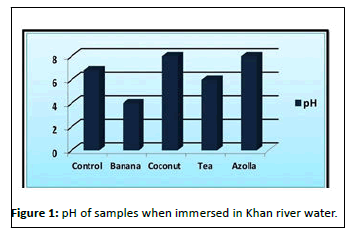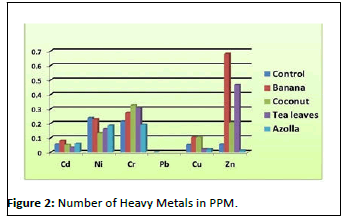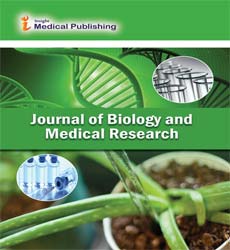A Comparative Analysis of phytoremediation abilities of Biodegradable Filtrates and Azolla Fern in biofilteration of Heavy Metals
Charvi Gangwani*
1Department of Neuroscience, Hollins University, Virginia, United States
- *Corresponding Author:
- Charvi Gangwani ahim
Department of Biology, Hollins University, Virginia, United States
Tel: 15404676505
E-mail: neuroscience03@gmail.com
Received Date: December 03, 2021; Accepted Date: December 16, 2021; Published Date: December 23, 2021
Citation: Gangwani C (2021) A Comparative Analysis of Phytoremediation Abilities of Biodegradable Filtrates and Azol la Fern in Biofiltration of Heavy Metals. J Biol Med Res Vol.4 No.7
Abstract
The ecological health of many river systems in India is threatened by numerous chemicals and waste discarded by industries such as the mining, milling, plating and surface finishing industry. As a result, concentration of toxic heavy metals is increasing at an alarming rate leading to non-biodegradability and bioaccumulation. This study was undertaken to better understand the heavy metal accumulation potential between biodegradable filtrates (banana, coconut, and tea leaves) and Azolla pinnata and to determine the ideal choice in bio filtration of Khan River water. Results showed that Azolla had a high potential for the removal of heavy metals from water resources as compared to biodegradable filtrates and it can be used in phytoremediation of heavy metals in environmental refinement projects. The pH of the water sample also came down after the treatment and was brought more towards neutral due to the absorption of the ions and other organic pollutants present in the water sample by Azolla.
Keywords
Heavymetalaccumulation,Phytoremediation,KhanRiver,Azollapinnata,Biodegradable filtrates
Introduction
42 rivers in India have extremely high concentrations of neurotoxic heavy metals. 137 rivers possess at least 2 toxic heavy metals beyond permissible limits. Heavy metals are metallic chemical elements that have relatively high density and are toxic and poisonous. They are dangerous because they tend to bio accumulate. Heavy metal toxicity has several health effects in the human body. They can damage and alter the functioning of organs such as brain, kidney, liver, lungs, and blood. Chronic long-term exposure may even cause cancer. Most of them enter the human body through unclean water, e.g., Mercury, Lead, Arsenic, Chromium, Nickel, Cadmium etc. Heavy metals are considered a dangerous threat to the environment due to three key criteria, i.e., persistence, bioaccumulation, and toxicity. Heavy metals are non-degradable chemical residues which possess long persistence timeswithin theenvironment and gradually enter food chains and accumulate within higher trophic levels, endangering both animal and human life. Therefore, the mitigation or attenuation of heavy metals from polluted aquatic environments is of great importance in protecting both the environment and human health. Heavy metals from aquatic environmentsare oftenremoved bya spreadof techniques which include chemical, physical and biological techniqueslikeprecipitation,natural process, chemical reduction and oxidation, membrane filtration, solvent extraction, reverse osmosis andactivated charcoaladsorption. However, the applicationsof thoseadvanced remediation strategies are limited especially in developing countries asthey arenot economically feasibleand needhigh sophisticated equipmentwhich maybe expensiveto accumulate. Generation of secondary wastes, metal specificity and suitability onlyduring anarrow range of concentrations, arethe oppositemajor limitations of the above methods. Phytoremediation is a plant-based approach, which involves the use of plants to extract and remove elemental pollutants or lower their bioavailability in soil [1]. Phytoremediation is a low-cost green technology and has been shown to be effective in diverse aquatic systems including reservoirs and ponds. Certain plants known as hyper accumulators can absorb heavy metals whichhaven't anyimportance for plant metabolic processes. These hyper accumulating plants which possess the capacity to absorb non-essential heavy metals are suitable candidates for efficient phytoremediation. In hyper accumulation, heavy metal pollutants are absorbed by the roots of the plants and are concentratedwithin theplant tissues or decomposed to less harmful forms. Plants that can absorb and tolerate high levels of heavy metals are considered as potent candidates of phytoremediation. Floating aquatic macrophytes are defined as plants that float on the water surface with submerged roots. Many aquatic macrophytes are potential candidates of phytoremediation as they demonstrate strong capacities to absorb nonessential heavy metals and concentrate them in tissues [2]. In addition, the rapid proliferation and direct contact of aquatic macrophytes with the contaminated environment facilitates the purification process and ensures the sanitation of polluted water bodies [3-5]. The present study investigates the growth performance and phytoremediation potential of Biodegradable filtrates and A. pinnata on Khan River water. Studies of this nature can help us determine whether the samples can be utilized for the purpose of phyto technology of produced water [6].
Materials and Methods
The aquatic macrophyte used for this experiment was A. pinnata collected from Bilavali lake wetland area, Indore and transported to the laboratory in clean plastic bags. The produced water used for this study was collected from Khan River, Indore. All the samples of biodegradable filtrates were dried in the Sun and were kept in the incubator. Later they were grinded into powder. 10 gm of the powder of each sample was packed in muslin cloth bags to make filters. 250 ml of Khan River water was taken in each of the three beakers. The above-mentioned filters (coconut fibres, banana peels and tea leaves) were immersed in the three beakers containing water. This setup was left for almost 5 days to observe their effects on the river’s water [7]. Khan River water was also taken in a large glass aquarium and azolla fern was put in for proliferation for about a week. This was done to replicate the river like situation. The proliferated azolla was put in 250 ml Khan River water in a beaker and left for observation after 5 days. Samples (1 control and 4 experimental) were filtered and sent to the laboratory for analysis of heavy metals. The pH of the water sample is checked by using a pH Meter [8]. The pH of the water sample is checked on the first day before treatment with Azolla and then on the 5th day after treatment with Azolla and filtrates, and the change in pH (if any) is recorded [14].
Results and Discussion
It was found that A. pinnata removed the heavy metals cadmium, nickel, chromium, lead, copper and zinc from polluted water. This may be a result of absorption of the ions and other organic pollutants present in the water sample by Azolla [9]. Azolla exhibits a remarkable ability to concentrate metals Cu, Cd, Cr, Ni, Pb and nutrients directly from pollutants or sewage water. After Azolla treatment, the pH of the water is brought more towards neutral, i.e., it has become more portable as a result of Azolla treatment. Azolla acts as an excellent source of bioremediation for the uptake of heavy metals from Khan River water and can be used in various areas like in factories, horticulture, laundry etc. [10].
Table 1: Number of heavy metals in different samples of biodegradable filtrates and Azolla fern when immersed in Khan River water.
| Heavy Metal | Control | Banana | Coconut | Tea leaves | Azolla |
|---|---|---|---|---|---|
| Cd | 0.0549 | 0.0797 | 0.0512 | 0.0343 | 0.0605 |
| Ni | 0.2375 | 0.2294 | 0.1323 | 0.1606 | 0.1849 |
| Cr | 0.2137 | 0.2735 | 0.3248 | 0.3077 | 0.1906 |
| Pb | N/D | N/D | N/D | N/D | N/D |
| Cu | 0.0509 | 0.1043 | 0.1043 | 0.0204 | 0.0204 |
| Zn | 0.0545 | 0.6812 | 0.2054 | 0.4652 | 0.0132 |
The graph indicates that the heavy metal uptake is maximum by Azolla as compared to tea wastes, coconut, and banana peel filtrates. The result indicates that pH of Azolla and coconut is alkaline, which must have helped in making some complexes which reduced the uptake of heavy metals from the control sample [11]. Banana showed less heavy metal uptake which may be due to its low pH.
Conclusion
To mitigate heavy metal contamination, Phytoremediation proves to be a highly efficient technique. From the above observation it can be concluded that Azolla is an ideal choice to carry out phytoremediation in Khan River and can be used for the treatment of wastewater such as industrial effluents, sewage water etc. on a large scale in comparison to biodegradable filtrates. The wastewater treatment processes employing Azolla are advantageous over chemical methods, as they are eco-friendly and effective [12]. In addition, Azolla has high multiplication rate, high biomass production, global distribution, and prime growth habitat [15]. The direct use of Azolla with distinctive feature of catabolic potential and its products such as enzymes and bio surfactant are a novel approach to enhance and boost their remediation efficacy [13]. The heavy metals all form cations (Ni2+, Cu2+, Pb2+) which bind with the negatively charged sites of Azolla such as hydroxyl, alcohol, phosphoryl, amine, carboxyl, ester, sulphydryl, sulfonate, thioether and thiol groups help in the abatement of heavy metal pollution in aquatic ecosystems receiving industrial effluents and municipal wastewater [16].
Suggestions
The slow growth and low biomass can be combatted by genetically engineering approaches to modify hyper accumulators with desired traits such as high heavy toleration and accumulation. Furthermore, the process of bioremediation can be incorporated which is a process used to treat contaminated media such as water and soil, by altering environmental conditions to stimulate growth of microorganisms and degrade the target pollutants. Many microorganisms, including fungi, bacteria, and protists, can break down organic toxins, transforming them into harmless products such as water and carbon. A combination of bioremediation techniques and genetic engineering methods is essential for highly effective and exhaustive phytoremediation in the future.
Limitations of Research
Phytoremediation is a time-consuming process, taking a long time to process heavy-metal contaminated water. The slow growth and low biomass require a long-term commitment.
Acknowledgement
I am grateful to the Principal and Science Department of Choithram School, Indore for facilitating the opportunity to carry out the research work.
References
- Arora A, Singh PK (2001) Use of Azolla in Bioremediation. Recent advances in Exploitation of Blue Green Algae and Azolla, Venus Printers and Publishers, New Delhi
- Salt DE, Blaylock M, kumar PBAN, Dushenkov V, Ensley BD, et al. (1995) Chet L, Raskin L. Phytoremediation: A novel strategy for the removal of toxic metals from the environment using plants. Biotechnology 13:468–474
- Sachdeva S, Sharma A (2012) Azolla: role in phytoremediation of heavy metals. Int J Eng Sci 1:9698
- Zimmermann WJ, Watanable I, Lumpkin TA (1991) The Anabaena- Azolla symbiosis: diversity and relatedness of neotropical host taxa. Plant Soil 137:167-170
- Roger PA, Renaud PA (1979) Ecology of blue green algae in paddy fields in nitrogen and rice IRRI, Los Benos 289-309
- Peters GA, Calvert HE (1983) The Azolla-Anabaena, symbiosis, Cambridge Univ. Press Cambridge :109-145
- Lumpkin TA, Pluckmett DL (1980) Azolla- Botany, Physiology and use as a green manure. Econ Bot 34:111-153
- Peters GA, Evans WR, Crist DR, Mayne BC, Poole RE (1980) Characterization and comparison of five nitrogenfixing Azolla-Anabaena association I. optimization of growth conditions for biomass increase and N- content in controlled environment. Plant Cell Environ 3:261-269
- Hates B, Frank O, Angells BD, Feingold S (1980) Plasma tocopherol in man at various times after ingesting free or acetylaned tocoherol. Nutr Rep Int 21:531-536.
- Grilli Caiola M, Fornic C, Castagnola M (1988) Bacteria in the Azolla – Anabaena association Symbiosis. 2:185-198
- Van Hove C (1989) Azolla and its multiple use with emphasis on Africa. Food and Agriculture Organization, Rome 21
- Marwaha TS, Singh BV, Goyal SK (1992) Effects of incorporation of Azolla on wheat (Triticum aestivum var. HD2329), Acta Bot Indica 20:218-220
- Teckle-Haimanot EVD (1995) Comparison of Azolla mexicana and N and P Fertilization on Paddy taro (Colocasia esculenta) yield. Trop Agric 72:70-72
- Ito O, Watanabe I (1985) Availability to rice plants of nitrogen fixed by Azolla. Soil Sci Pl Nutr 34:91-104
- Sharma MP, Singh R, Singh R (1999) Effect of Azolla on wheat (Triticum aestivum) yield and soil properties. Indian J Agric Sci 69:55-57
- Kolhe SS, Mittra BN (1990) Azolla as an organic source of nitrogen in rice-wheat cropping system. Trop Agric 67:267-269
Open Access Journals
- Aquaculture & Veterinary Science
- Chemistry & Chemical Sciences
- Clinical Sciences
- Engineering
- General Science
- Genetics & Molecular Biology
- Health Care & Nursing
- Immunology & Microbiology
- Materials Science
- Mathematics & Physics
- Medical Sciences
- Neurology & Psychiatry
- Oncology & Cancer Science
- Pharmaceutical Sciences


